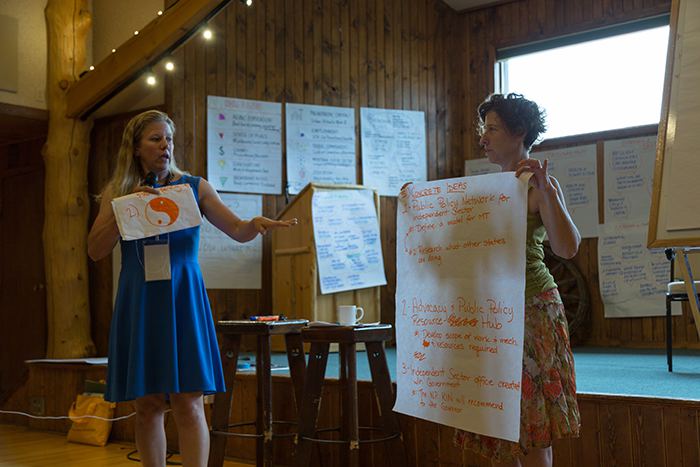
Caitlin Copple, Montana Correspondent
Against the backdrop of Lone Mountain on a patio with a river rock fireplace, nearly 100 philanthropists, social entrepreneurs, nonprofit staff and government leaders spent a day and a half talking, thinking and planning next steps to advance issues that matter most to Montanans.
Philanthropy Northwest presented Local Matters: Montana at Big Sky on June 17 and 18 to discuss, mostly in small groups, how best to move the needle on collaboration, inclusion and impact investing to address specific issues like Indian health and early childhood education. A major focus of the convening was creating effective partnerships and building the national, regional and local networks needed to impact the greatest social challenges of our time.
As a board member of the Women’s Foundation of Montana, which focuses on STEM education and supporting women entrepreneurs in the state, I was particularly interested in the breakout session around creative uses of capital. I’d personally love to see our endowment invested in a way that advances our cause but still offers great returns. Philanthropists are rarely of one mind, but our group came to consensus on some of the tensions and opportunities related to using financial capital in new ways, then shared our suggestions and heard from others as the conference wrapped up Thursday afternoon.
Moving Forward on Place-Based Impact Investing
Bill Stoddart of Bozeman’s NorthFork Financial observed that many foundations continue to primarily employ a grant model, viewing creative vehicles as inherently risky. Yet from one perspective, few investment tools are riskier than grants, which by design offer zero finanicial return. Another concern he hears is related to compliance with IRS regulations: most foundations don’t understand or have access to counsel that helps them leverage the regulations to make creative investments focused on outcomes.
The group agreed that Wall Street doesn’t represent the interests of most foundation boards; entrenched interests there make change feel impossible and the concept of supporting one’s local community feels nonexistent. If more foundations or nonprofit endowments invested their capital in projects to benefit grantees or collective risk pools to solve community problems, as with the Pay for Success model, they could do a whole lot more good and better meet their missions. This sort of impact investing is increasingly in demand, but remains somewhat scary to many players in our sector. Individual investors also want more options than Wall Street or a socially responsible mutual fund that gets poor returns and is not connected to the local community, and SEC rules are responding to the crowdfunding movement. Philanthropy can and should step up to fill this need, and one way is through greater business involvement.
Some of the next steps we identified:
- Spotlight foundations that are doing this in creative, accessible ways so others have local and/or regional examples. Provide a toolbox to legitimize the tools that leaders can present to their boards.
- Leverage the network built at Local Matters: Montana to identify critical needs in a community and then build specific investment opportunities (business or nonprofit program) into investable opportunities.
- Find funders who will underwrite a Montana pool to make program-related investments more attractive to organizations who are new to this world. Use Meyer Memorial Trust’s Invest Oregon as a model for our state.
- Advocate for accelerating the commoditization of portfolio of funds that fund at the community development corporation level or the individual impact investiment level.
- Find creative ways to incentivize collective impact at the government, nonprofit, and foundation levels and to include metrics other than market value or traditional return on investment.
- Lobby for an updated definition of “fiduciary responsibility” which is based on 150 years of case law but feels outdated and restricted.
- Advocate for SASB federal accounting standards rather than the traditional FASB, which is seen as more restrictive.
Networking, Policymaking and Inclusion
The half-dozen other groups focused on a range of topics, but there was considerable overlap when we came back together to share takeaways, which revolved around the ongoing opportunities for building a social sector that is more collaborative, more inclusive and better connected across sectors.
The networking group, led by the Missoula Community Foundation’s Meredith Printz and Emily Fleming from the Student Assistance Foundation, suggested establishing a statewide fund for mission-related investments.
“I came here because I work for a for-profit company that does infrastructure projects that nonprofits don’t want to get involved in,” said Becky Bey of Bozeman's KLJ Engineering, which played a large role in advocating for early childhood education last legislative session. “[Many] funders don’t want to touch something like a wastewater treatment plant, but that’s what we do, and it’s what communities need. How can we have more private interests make money while achieving community projects? We need to find ways to make this profitable and make it sexy."

Amy Hyfield, O.P. & W.E. Edwards Foundation and Audrey Haberman, The Giving Practice
Another group that focused on government and philanthropy, led by Amy Hyfield of O.P. & W.E. Edwards Foundation in Red Lodge, suggested having the Montana Nonprofit Association serve as an advocacy and resource hub related to advocating for the sector as a whole, and establishing an independent sector office within government, perhaps in the Department of Commerce, with a staff liaison dedicated to helping nonprofits navigate government contracts.
The group focused on inclusion said more foundations and nonprofits need to invest in up-front planning, noting that there were few people of color in the room.
Johnel Barcus of Sage Quest Consulting in Billings said Native voices are underrepresented in this conversation and that a big part of capital is relationships, which depend on trust. Because trust varies between organizations, cultures, and the philanthropic, nonprofit, and corporate sectors, creative uses of capital can be hard to identify and navigate. People have different thresholds for risk-taking, and different values and communication styles.
Another group offered a metaphor for something many in the sector can relate to when it comes to collaboration:
“It can feel like we are all driving in separate cars going different directions, but we want to all get on the same bus, identify and establish common goals, and then build trust and educate ourselves about one another so we can break down competition,” said Anne Beach, Seeley Lake Community Foundation director.
Local Matters:Montana is a great first step toward getting Montana’s elected officials, nonprofit leaders and funders on the same bus, driving together toward a brighter future.
Highlighted tweets and photos from participants at Local Matters: Montana
Big thanks to Local Matters: Montana sponsors Dennis & Phyllis Washington Foundation, First Interstate BancSystem Foundation, Montana Community Foundation, O.P. & W.E. Edwards Foundation and Montana Healthcare Foundation, as well as series sponsors Foundant Technologies, JPMorgan Chase and The Paul G. Allen Family Foundation.
Local Matters is Philanthropy Northwest's series of convenings in Alaska, Idaho, Montana, Oregon, Washington and Wyoming. For more information, contact Lyn Hunter or visit the Local Matters page.


